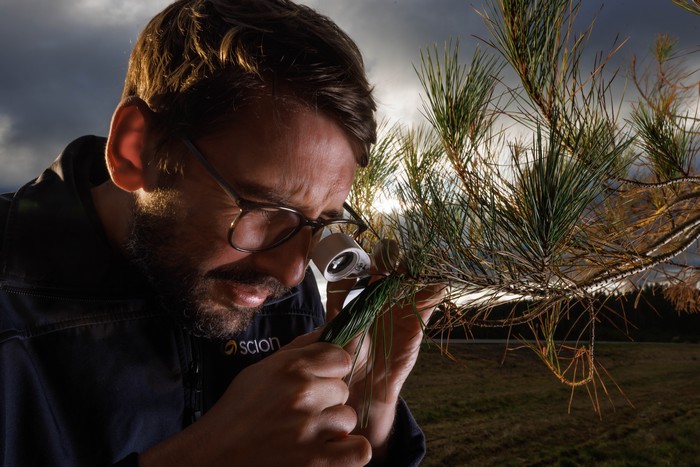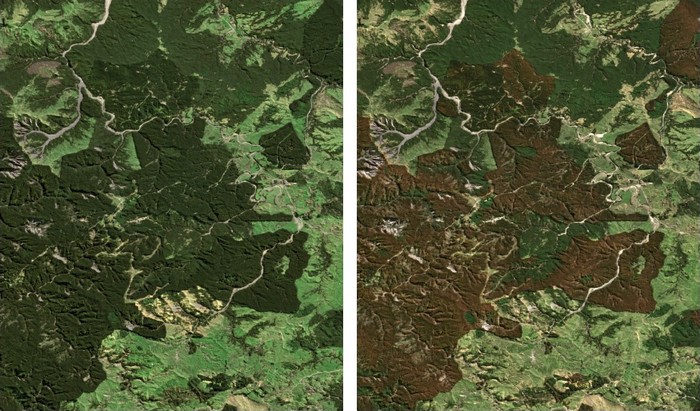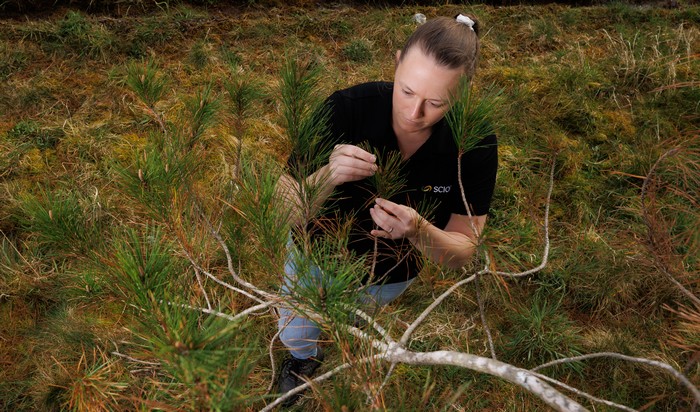Future-proofing our forests
Research provides a beacon of hope for foresters grappling with a disease impacting tree health and timber growth.
New research and smart technologies are offering hope and solutions to foresters waging war against a silent enemy in our pine plantations.

Red needle cast (RNC), an unyielding fungal-like disease, has silently been affecting pine trees in New Zealand since at least 2008. Infections cause pine needles to lose their colour and fall to the ground, with research showing how defoliation can impact growth for three years after the trees show symptoms.
Scientists from Scion’s Resilient Forests Research Programme are at the forefront of New Zealand’s response, with their work providing hope for forest growers striving to mitigate the combined impact of invasive pathogens and climate change’s impact on tree health, and on the timber industry’s growth and productivity.
Dr Stuart Fraser, a research group leader in Scion’s Ecology and Environment team, has spent more than six years exploring red needle cast disease and possible control measures. In 2021, forest pathologist Emily McLay joined him on the frontline to further unravel its mysteries.
Caused by infection from Phytophthora pluvialis, the disease is predominately found on the East Coast and in the Central North Island, but more reports are being received from Northland to Southland.
“We thought there were disease seasons, but the 2022-23 season essentially didn’t end because we had such a long, wet summer,” McLay says.
“Normally over summer when it’s drier and hotter, you get a reset in the disease cycle because the weather typically stops it from progressing. But extended wet seasons are reasons why the disease has been so prevalent this year. It’s just built and built.”
She suggests there is a likely climate change element at play, with extreme wet years promoting the disease’s proliferation. “We are in a new normal,” she says.
The alternating cycle of La Niña and El Niño weather patterns has exacerbated the issue. When New Zealand experiences wetter than usual years, like the recent La Niñas, it provides the ideal breeding ground for RNC.

Cracking the disease code
The key to combatting RNC lies in understanding the intricacies of its life cycle. McLay has been working in the lab with a focus on research to understand how temperature and moisture drive different processes in the disease cycle. “It’s a targeted study that we can use to build epidemiological models so we can predict when these big years might happen,” she says.
This research has shed light on the pathogen-host interaction and how the environment influences it. RNC completes its life cycle on the needles of radiata pine trees and is a very ‘plastic’ pathogen that can very quickly respond to environmental stimuli. “This allows the pathogen to save its resources until the perfect conditions to release spores and infect its host,” she says.
Temperature and wetness are the dynamic duo fuelling RNC’s relentless attack. While these factors are inherently linked to seasonal changes, McLay’s research aims to separate and analyse their individual impacts on different stages of the disease cycle.
“One of the challenging aspects about field trials is that there’s co-variation. Winter is typically colder and wetter, whereas summer is warmer and drier. When it comes to building a model, it’s really hard to pull those apart.” Her research, therefore, focuses on teasing out the influence of temperature and wetness, shedding light on their distinct roles.
The goal is not just to treat the disease but also to do so in a way that’s environmentally responsible and economically viable. - Dr Stuart Fraser
Monitoring support
To support the forestry industry and Scion’s pathologists to better understand the extent of RNC, Scion’s Remote Sensing and Geospatial Intelligence team provide monitoring support. Using satellite data, they can map the spread of the disease across forested regions. However, this poses its own set of challenges.
Monitoring forests for disease from space can be a bit like looking at the world through a straw. While they can detect the disease when it reaches the upper canopy, the lower branches, where RNC typically starts, often escapes detection. The key to more accurate detection and modelling lies in receiving tips from industry about areas where RNC is suspected.
Former team lead Grant Pearse explains, “We use free, coarser resolution satellite imagery to identify areas that might have disease expression. But it can generate some false positives for various reasons.
“The presence of RNC can only be confirmed through the purchase of very high-resolution satellite imagery from a commercial provider for more detailed mapping. To make our modelling more accurate, we’d love to hear more from industry about areas where RNC could be impacting forests. Having more accurate data means we’ll need to investigate fewer false positives long-term.
“Ideally, we are looking for larger areas of trees affected by RNC as satellites struggle to detect a few roadside trees, for example.”
It further supports the argument that the battle against RNC is not one that can be fought in isolation. McLay, Fraser and their team stress the importance of collaboration, particularly with industry professionals with intimate knowledge of forest conditions who can provide information that helps to validate the models being developed.

Creating decision tools
As the battle against RNC intensifies, the need for practical solutions becomes increasingly evident. Copper, a familiar ally to foresters, is emerging as a potential saviour.
Copper has been used in low doses as a control tool for Dothistroma needle blight, a fungal needle disease similar to RNC, for about 60 years. The Central North Island is considered ‘ground zero’ for Dothistroma in New Zealand and its effectiveness has been duly tested in pine plantations. Fraser has been at the forefront of researching copper treatments for RNC since 2017.
Significant RNC outbreaks in 2015 and 2016 in several Central North Island plantations prompted Mike Baker, national forestry manager at Manulife Forest Management (NZ), to contact Scion pathologists to propose the first operational-scale copper trials. This began an ongoing partnership between Scion and Manulife, with copper trials implemented and assessed in mature stands at Kinleith Forest annually from 2017.
Results from the 2017 and 2019 trials demonstrated that cuprous oxide applied at the standard dose currently used to control Dothistroma significantly reduced RNC severity.
These trials were also the first to investigate optimal spray timing for control of RNC, testing the hypothesis that late summer or autumn sprays may be best. Spray treatments in November, February and April (or May) were tested in 2018 and 2019; however, no consistent effect of spray timing was observed. Generally, disease severity was reduced under all three spray timings compared to the unsprayed control. Disease levels were relatively low during the period when spray timing was tested, but it’s hoped copper trials on East Coast forests will shed more light on the effectiveness of copper under greater disease pressure.
While there’s already strong signs that copper is an effective tool to curb the spread of RNC, Fraser cautions that its application needs to be carefully considered.
“The goal is not just to treat the disease but also to do so in a way that’s environmentally responsible and economically viable.”
Understanding the disease’s behaviour in the context of changing environmental conditions is crucial for mitigating its impact. - Paul Adams
A glimpse into the future
As we strive to protect New Zealand’s planted forests from RNC, hope is emerging.
McLay’s research is building towards the development of a prototype model that will provide predictive insights into disease outbreaks. This tool, while a few years from being rolled out commercially, will empower foresters with the information needed to take timely, preventative action.
Combined with the satellite-based monitoring framework developed by Scion and Indufor, and ongoing copper treatment research, they are revolutionising disease management.
“It’s not just about reacting to outbreaks but proactively identifying and addressing potential trouble spots,” McLay says.
Forest Growers Research chief executive Paul Adams says Scion’s research offers industry a beacon of hope for safeguarding New Zealand’s forests and sustaining the timber industry.
“It holds immense value for our forestry sector. Understanding the disease’s behaviour in the context of changing environmental conditions is crucial for mitigating its impact.”
Adams adds that the collaboration between scientists and forestry professionals underscores the importance of a collective effort in combating RNC.
“The potential use of copper treatments is promising. Combined with the development of predictive models and satellite-based monitoring, these research efforts will help our future forests be more resilient in the face of climate change.”
The Resilient Forests Research Programme has been funded to the tune of more than $18 million over five years from Scion’s Strategic Science Investment Fund and the Forest Growers Levy Trust.
